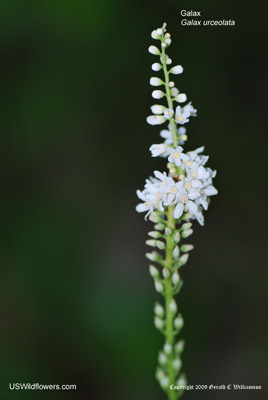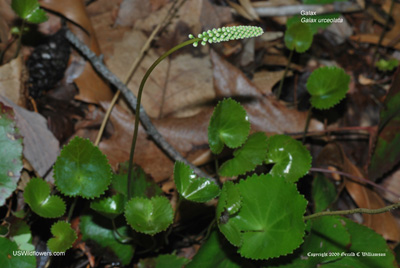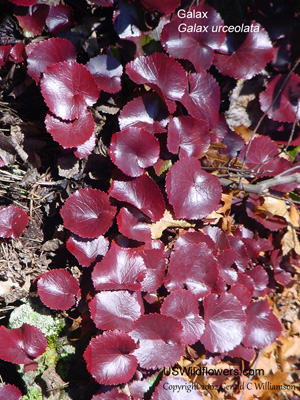Beetleweed, Galax, Wandplant, Wandflower, Coltsfoot - Galax urceolata
|
Galax urceolata - Beetleweed, Galax, Wandplant, Wandflower, Coltsfoot. Galax urceolata is monotypic - the only species in the genus. It is a member of the Diapensiaceae family, which in itself is rather small, having only around 14 species. Of these, 6 are found in North America, with the others in Europe and Asia.
While Galax is native to the southeastern United States, disjunct populations that found in New York and Massachusetts are likely not native; probably naturalized garden escapees.
Found in:
AL, GA, KY, MA, NC, NY, OH, SC, TN, VA, WV
Leave comments on Galax urceolata at this link. | 
Distribution of Galax urceolata in the United States and Canada:

Blue=Native; Grey=Introduced
Map from USDA Plants Database:
USDA, NRCS. 2017. The PLANTS Database (http://plants.usda.gov, 08 May 2025). National Plant Data Team, Greensboro, NC 27401-4901 USA.
Search Our Database: Enter any portion of the Scientific, Common Name, or both.
Do a general Google search of the entire site:
#ad
 Follow USWildflowers on Twitter
| | Site: Polk County, TN Date: 2004-May-30 | Photographer: Gerald C Williamson | | Galax' flower cluster terminates the long stem that rises from the basal leaves. | | 
| | Site: Polk County, TN Date: 2009-May-30 | Photographer: Gerald C Williamson
Nikon D60
Tamron SP 90MM f/2.8 AF Macro
90mm (135 equiv) Flash: Yes | | | | Click on the photo for a larger image

| | Site: Big Frog Trail, Polk County, TN Date: 2009-May-08 | Photographer: Gerald C Williamson
Nikon D60
Tamron SP 90MM f/2.8 AF Macro
90mm (135 equiv) Flash: Yes | | In the past there was a large industry collecting Galax for the attractive, shiny leaves to use in floral arrangements. | | Click on the photo for a larger image

| | Site: Tray Mountain, Towns County, GA Date: 2002-December-20 | Photographer: Gerald C Williamson
Sony Cybershot | | Galax is an evergreen in the sense that it doesn't lose its leaves over winter, but "green" may not be appropo. Instead, they usually turn a beautiful burgundy red color. This is one of my earlier wildflower photographs. | | Click on the photo for a larger image

|
References used for identification and information:
|
|
| |
| #ad
|
|






